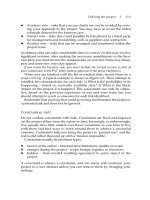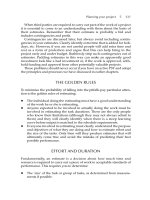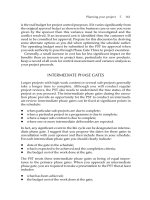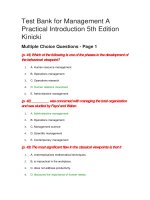Management a practical introduction 3rd kinicky chapter 08
Bạn đang xem bản rút gọn của tài liệu. Xem và tải ngay bản đầy đủ của tài liệu tại đây (566.96 KB, 60 trang )
Management
A Practical Introduction
Third Edition
Angelo Kinicki &
Brian K. Williams
Kinicki/Williams, Management: A Practical Introduction 3e ©2008, McGraw-Hill/Irwin
Chapter 8: Organizational Culture,
Structure, & Design
Building Blocks of the
Organization
What Kind of Organizational Culture Do We Have?
Developing High Performance Cultures
What is an Organization?
Elements of an Organization
Types of Organizational Cultures
Creating the Best Structure
Building a Learning Organization
Kinicki/Williams, Management: A Practical Introduction 3e ©2008, McGraw-Hill/Irwin
8.1 What Kind Of Organizational Culture
Will You Be Operating In?
WHAT IS AN ORGANIZATIONAL CULTURE?
Organizational culture (also called corporate
culture) is a system of shared beliefs and values that
develops within an organization and guides the
behavior of its members
It is the organization’s personality
There are two levels of corporate culture:
The invisible level
The visible level
Kinicki/Williams, Management: A Practical Introduction 3e ©2008, McGraw-Hill/Irwin
Layers of Organizational Culture
Invisible Level: Core Culture
Not seen by the naked eye.
Consists of values, beliefs, and assumptions
Core culture might be associated with “it’s the
way we do things around here”
Often has two sources:
1) Visions, assumptions, and biases of founders
2) Outlook that initial employees learned from
their own experiences
McGraw-Hill/Irwin
Kinicki/Williams, Management: A Practical Introduction
3e ©2008,
McGraw-Hill/Irwin
© 2006
The McGraw-Hill
Companies, Inc. All rights rese
Layers of Organizational Culture
Visible Level:
Observable culture
Manifestations of culture:
Symbols
Stories
Heroes
Rites and rituals
McGraw-Hill/Irwin
Kinicki/Williams, Management: A Practical Introduction
3e ©2008,
McGraw-Hill/Irwin
© 2006
The McGraw-Hill
Companies, Inc. All rights rese
8.1 What Kind Of Organizational Culture
Will You Be Operating In?
-symbols are objects, acts, qualities, or events that
convey meaning to others
-stories are narratives based on true events which
are repeated and sometimes embellished to
emphasize a particular value
-heroes are people whose accomplishments
embody the values of the organization
-rites and rituals are the activities and ceremonies,
planned and unplanned, that celebrate important
occasions and accomplishments in the organization’s
life
Kinicki/Williams, Management: A Practical Introduction 3e ©2008, McGraw-Hill/Irwin
8.1 What Kind Of Organizational Culture
Will You Be Operating In?
WHY IS CULTURE IMPORTANT?
1. Culture provides an opportunity to reinforce the
company’s message
2. Culture helps to get everyone on board
3. Culture helps companies manage conflict and
change effectively
4. Culture helps employees understand why the
company does what it does and how it will achieve its
long term goals
Kinicki/Williams, Management: A Practical Introduction 3e ©2008, McGraw-Hill/Irwin
Four Functions of Organizational Culture
It gives members an organizational identity
It facilitates collective commitment
It promotes social-system stability
It shapes behavior by helping employees make
sense of their surroundings
McGraw-Hill/Irwin
Kinicki/Williams, Management: A Practical Introduction
3e ©2008,
McGraw-Hill/Irwin
© 2006
The McGraw-Hill
Companies, Inc. All rights rese
8.1 What Kind Of Organizational Culture
Will You Be Operating In?
Figure 8.1: Four Functions Of Organizational Culture
Kinicki/Williams, Management: A Practical Introduction 3e ©2008, McGraw-Hill/Irwin
8.2 Developing High-Performance Cultures
WHAT ORGANIZATIONAL CULTURE ENHANCES
ECONOMIC PERFORMANCE?
There are three perspectives of how culture can enhance
performance:
1. The strength perspective assumes that the strength of a
corporate culture is related to a firm’s long-term financial
success
2. The fit perspective assumes that an organization’s culture
must align or fit with its business or strategic context
3. The adaptive perspective assumes that the most effective
cultures help organizations anticipate and adapt to
environmental changes
Studies show that in the long-term, financial performance is
highest for firms with an adaptive culture
Kinicki/Williams, Management: A Practical Introduction 3e ©2008, McGraw-Hill/Irwin
8.2 Developing High-Performance Cultures
HOW CAN CULTURE BE EMBEDDED IN AN
ORGANIZATION?
The values and beliefs of a culture are shared with
members of the organization using a variety of mechanisms:
1. Formal Statements - culture can be embedded in an
organization through formal statements of philosophy, mission,
vision, and values
2. Slogans & Sayings - corporate cultures can be promoted
through slogans and sayings
3. Stories, Legends, & Myths - telling stories, legends, and
myths can help embed desirable values in an organization
4. Leader Reactions to Crises - how top managers respond to
critical incidents sends a message to employees
Kinicki/Williams, Management: A Practical Introduction 3e ©2008, McGraw-Hill/Irwin
8.2 Developing High-Performance Cultures
5. Role Modeling, Training, & Coaching - organizational
culture can be promoted through role modeling, training
programs, teaching, and coaching
6. Physical Design - the physical design of workspaces,
buildings, and so on can also help embed corporate culture
7. Rewards, Titles, Promotions, & Bonuses - companies use
rewards, status symbols, promotions, and so on to encourage
desirable organizational behavior
8. Organizational Goals & Performance Criteria - desired
organizational behavior and goals can be promoted through
criteria for recruiting, selecting, promoting, and dismissing
people
Kinicki/Williams, Management: A Practical Introduction 3e ©2008, McGraw-Hill/Irwin
8.2 Developing High-Performance Cultures
9. Measurable & Controllable Activities - companies can
measure and control certain activities to foster a certain
culture
10. Organizational Structure - how an organization is
structured can send a clear message about its organizational
culture
11. Procedures For Self-Development - procedures can be
established to help employees develop according to
organizational goals
Kinicki/Williams, Management: A Practical Introduction 3e ©2008, McGraw-Hill/Irwin
Practical Action: Fitting into an
Organization’s Culture
Get to know some people and listen to what they have to
say
Remember the seven second rule for first impressions
Make it easy for others to give you feedback
Get something done
McGraw-Hill/Irwin
Kinicki/Williams, Management: A Practical Introduction
3e ©2008,
McGraw-Hill/Irwin
© 2006
The McGraw-Hill
Companies, Inc. All rights rese
Practical Action: When You Should and
Shouldn’t Delegate
Delegate routine and technical matters
Delegate tasks that help your subordinates grow
Don’t delegate confidential and personal matters
Don’t delegate emergencies
Don’t delegate special tasks that your boss asked you to do
—unless you have his or her permission
Match the tasks delegated to your subordinates’ skills and
abilities
McGraw-Hill/Irwin
Kinicki/Williams, Management: A Practical Introduction
3e ©2008,
McGraw-Hill/Irwin
© 2006
The McGraw-Hill
Companies, Inc. All rights rese
8.3 What Is An Organization?
Organization: is a system of consciously coordinated
activities or forces of two or more people.
For profit organizations
Formed to make money by offering products or
services
Not-for-profit organizations
Formed to offer services to clients, not to make
profit for its owners (hospitals, colleges)
Mutual-benefit organizations
Voluntary collectives whose purpose is to advance
member interests (unions, trade associations)
McGraw-Hill/Irwin
Kinicki/Williams, Management: A Practical Introduction
3e ©2008,
McGraw-Hill/Irwin
© 2006
The McGraw-Hill
Companies, Inc. All rights rese
8.3 What Is An Organization?
HOW ARE ORGANIZATIONS STRUCTURED?
Organizations can be represented in an organization chart (a
box-and-lines illustration showing the formal lines of authority
and the organization’s official positions)
Kinicki/Williams, Management: A Practical Introduction 3e ©2008, McGraw-Hill/Irwin
8.3 What Is An Organization?
Figure 8.2: Organization Chart
Kinicki/Williams, Management: A Practical Introduction 3e ©2008, McGraw-Hill/Irwin
The Organization Chart
Board of
Directors
Strategic
Planning Advisor
Chief Executive
Officer
Legal Counsel
President
Cost Containment
Staff
Executive
Administrative
Director
Director of
Director of
Personnel
Admissions
Director of
Patient &
Public
Relations
McGraw-Hill/Irwin
Executive
Medical Director
Director of
Nutrition &
Food
Services
Director of
Accounting
Director of
X-Ray &
Laboratory
Services
Director of
Chief
Physician
Pharmacy
Director of
Surgery
Director of
Outpatient
Services
Kinicki/Williams, Management: A Practical Introduction
3e ©2008,
McGraw-Hill/Irwin
© 2006
The McGraw-Hill
Companies, Inc. All rights rese
8.3 What Is An Organization?
The vertical hierarchy of an organization shows the
chain of command, and the official communication
network
The horizontal specialization shows the different
jobs or work specialization of an organization
Kinicki/Williams, Management: A Practical Introduction 3e ©2008, McGraw-Hill/Irwin
8.4 The Major Elements Of An Organization
WHAT ARE THE COMMON ELEMENTS OF AN
ORGANIZATION?
There are seven elements common to all organizations:
1. Common Purpose - a common purpose unifies employees
or members and gives everyone an understanding of the
firm’s reason for being - mission
2. Coordinated Effort - organizations achieve a common
purpose by coordinating individual efforts into a group or
organization-wide effort
3. Division Of Labor - the arrangement of having discrete parts
of a task done by different people is referred to as work
specialization
Kinicki/Williams, Management: A Practical Introduction 3e ©2008, McGraw-Hill/Irwin
8.4 The Major Elements Of An Organization
4. Hierarchy Of Authority - the control mechanism for making
sure the right people do the right things at the right time is
called the hierarchy of authority or chain of command
5. Span Of Control - the span of control or span of
management refers to the number of people reporting directly
to a given manager
Kinicki/Williams, Management: A Practical Introduction 3e ©2008, McGraw-Hill/Irwin
Spans of Control: Narrow versus Wide
CEO
Narrow
T
M
F
T
M
F
F
M
F
F
F
M
F
F
F
F
F
M
F
F
F
F
M
F
F
F
F
M
F
F
M
F
F
F
F
F
F
CEO
M
M
F
F
T
M
Wide
F
Key:
T = Top manager
M = Middle manager
F = First-line (supervisory)
manager
F
F
McGraw-Hill/Irwin
M
F
M
F
F
M
F
M
F
F
M
F
M
F
F Kinicki/Williams,
F
F
F
F
F
F
F
F
Management: A Practical Introduction 3e ©2008, McGraw-Hill/Irwin
M
F
F
F
F
F
© 2006 The McGraw-Hill Companies, Inc. All rights rese
8.4 The Major Elements Of An Organization
6. Authority, Responsibility, & Delegation – authority,
accountability, responsibility, and the ability to delegate are all
part of an organization’s elements
7. Centralization Versus Decentralization - when important
decisions are made by higher-level managers, the
organization has centralized authority, when important
decisions are made by middle-level and supervisory-level
managers, the organization has decentralized authority
Kinicki/Williams, Management: A Practical Introduction 3e ©2008, McGraw-Hill/Irwin
Eight Organizational Structures
1) Simple structure: for the small firm
2) Functional structure: grouping by similar work specialties
3) Division structure: grouping by similarity of purpose
4) Conglomerate structure: grouping by industry
5) Hybrid structure: functional & divisional used within the same
organization
6) Matrix structure: a grid of functional & divisional for two chains of
command
7) Team-based structure: eliminating functional barriers to solve
problems
8) Network structure: connecting a central core to outside firms by
computer connections
McGraw-Hill/Irwin
Kinicki/Williams, Management: A Practical Introduction
3e ©2008,
McGraw-Hill/Irwin
© 2006
The McGraw-Hill
Companies, Inc. All rights rese









